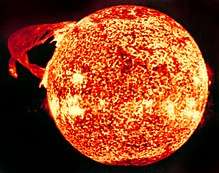Space Weather Follow-On L1
Space Weather Follow-On L1 (SWFO-L1) is a future spacecraft mission purposed for monitoring signs of solar storms, which may pose harm to Earth's telecommunication network. The spacecraft will be operated by the National Oceanic and Atmospheric Administration (NOAA), with a nominal launch schedule of 2024.[1] It is planned to be placed at the Sun–Earth L1 Lagrangian point, a location between the Earth and the Sun. This allows SWFO-L1 to continuously watch solar winds and energetic particles heading for Earth. SWFO-L1 is an ESPA Class Spacecraft, sized to be fitted around an Evolved Expendable Launch Vehicle Secondary Payload Adapter (ESPA) Grande ring while placed on a rocket.[1] The spacecraft's Solar Wind Instrument Suite (SWIS) which includes three instruments will monitor solar wind, and the Compact Coronagraph (CCOR) will monitor the Sun's surroundings to image coronal mass ejection (CME).[1] A CME is a large outburst of plasma sent from the Sun towards interplanetary space.
Together with space weather observation capabilities on the Earth-orbiting GOES-U satellite, SWFO-L1 constitutes the space segment of NOAA's Space Weather Follow-On (SWFO) program. The aim of the SWFO program is to ensure a robust continuity in space-based measurement of critical space weather environments.[2][3] Of the spacecraft located in L1 currently monitoring CME and solar wind, the Advanced Composition Explorer (ACE) is expected to consume its remaining propellant around 2024, and the ESA-NASA Solar and Heliospheric Observatory (SOHO) will cease operation before the mid-2020s.[4] SWFO-L1's SWIS instruments will succeed ACE's monitoring of solar wind and energetic particles, while CCOR will succeed from SOHO's LASCO (Large Angle and Spectrometric Coronagraph) instrument imaging of CMEs.[1]
Instruments
In April 2020, Southwest Research Institute was awarded a contract to supply SWFO-L1's magnetometer instrument.[5]
Launch
Space Weather Follow-On L1 is planned to be launched as a secondary payload on the rocket carrying NASA's Interstellar Mapping and Acceleration Probe (IMAP) spacecraft.[6] The launch service provider has yet to be selected.[7] As of 2019, launch is scheduled for October 2024[1][6].
References
- Ullman, Richard (26 June 2019). "NOAA's Current and Future Space Weather Observational Architecture" (PDF). Office of the Federal Coordinator for Meteorology. Retrieved 2019-10-16.
- Talaat, Elsayed (4 April 2019). "NOAA's Current and Future Space Weather Architecture" (PDF). Space Weather Prediction Center. Retrieved 2019-10-16.
- Onsager, Terry. "NOAA's Space Weather Plans" (PDF). Space Weather Prediction Center. Retrieved 2019-10-16.
- Werner, Debra (March 6, 2019). "Are small satellites the solution for space weather monitoring?". SpaceNews. Retrieved 2019-10-13.
- "NOAA's Space Weather Follow-On Lagrange 1 Magnetometer Awarded" (Press release). National Oceanic and Atmospheric Administration. 15 April 2020. Retrieved 28 April 2020.
- "NASA Selects Proposals to Further Study the Fundamental Nature of Space" (Press release). NASA. 13 August 2019. Retrieved 9 October 2019.
- Pietrobon, Steven (10 September 2019). "United States Commercial LV Launch Manifest". Retrieved 10 September 2019.

